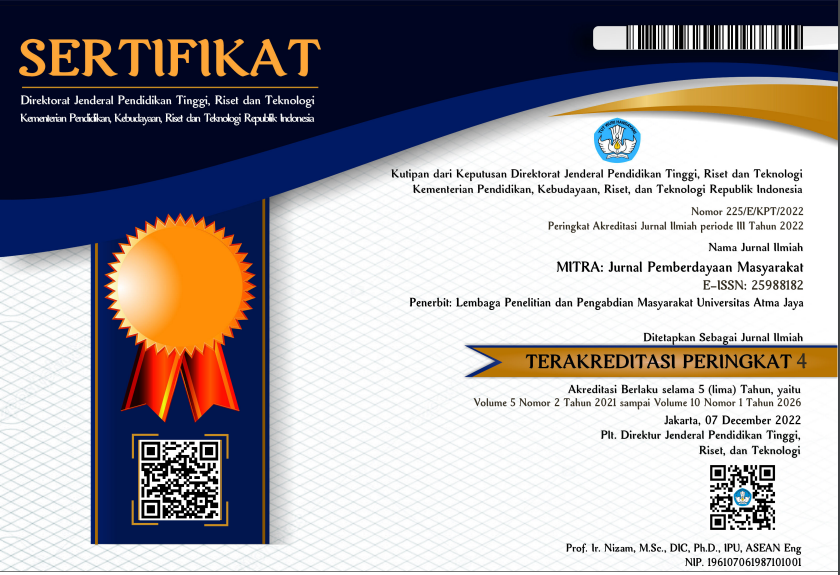Creating a Village Website as a Supporting Medium for Community Members’ Business Productivity
DOI:
https://doi.org/10.25170/mitra.v5i1.1860Keywords:
creative institutions, productivity, websiteAbstract
The covid-19 pandemic has worsened the economy of the informal sector. Online media may serve as one solution for opening new business spaces. The main problem encountered by our partner is the lack of understanding and use of digital media as a means of promotion. This activity aims to facilitate the creation of a village website as a supporting medium to increase the productivity of the residents.The partner of this community service program is the community members of RT 01 RW 34 Padukuhan Banjeng, Kanoman, Maguwoharjo, Depok, Sleman. This activity employed the Participatory Rural Appraisal (PRA) method. The implementation of these community service activities have successfully increased four aspects of community members’ productivity: 1) human development, shown by the higher understanding and ability in using the website to promote their business and increase the value of their business products; 2) business development, demonstrated by the enthusiasm of seventeen business owners in adding content to the website and in giving access to community members to help develop their digital-based businesses; 3) environmental development, manifested in pictures of the village on the website to provide a good impression of the village; and 4) institutional development, illustrated by the initiation of a new institutional model to ensure the sustainable use of the website, as a digital media to promote the community members’businesses.
References
Adriani, D., Sjarkowie, F., Minha, A., Alamsyah, I., & Yazid, M. (2020). Pelatihan perencanaan partisipatif bagi masyarakat dalam rangka pemanfaatan dana desa yang efektif dan efisien di Desa Sejaro Sakti. Abdimas Altruis, 3(1), 37–44.
Andrey, Chandra & Prasetya. (2015). Kualitas kerja, kepemimpinan, dan kompensasi pada PT. KMK Global Sports. E-Jurnal Widya Ekonomika, 1, 58–63.
Indonesia. (2007). Undang-Undang Republik Indonesia Nomor 24 Tahun 2007 tentang Penanggulangan Bencana.
Mardiyah, R. A. & Nurwati, R. N. (n.d.). Dampak pandemi covid-19 terhadap peningkatan angka pengangguran di Indonesia.https://www.academia.edu/download/63135109/
Artikel_Studi_Kependudukan_Rahma_Ainul_Mardiyah_
17031018007620200429-102148-10xmp8n.pdf
Muntoha, Jamroni & Tantria, H. (2015). Pemanfaatan situs web sebagai sarana promosi Desa Songbanyu, Kecamatan Giri Subo, Gunung Kidul, Daerah Istimewa Yogyakarta. Inovasi dan Kewirausahaan, 4(September), 172–176.
Mustanir, A., Ibrahim, M., Sapri, S., & Razak, M. R. R. (2020). Participatory rural appraisal: Transect dan matriks budidaya pertanian dalam pemberdayaan masyarakat penyiapan kebun bibit desa. Jurnal Masyarakat Mandiri (JMM), 4(5), 703–713. https://doi.org/10.31764/jmm.v4i5.2864
Rini, H. S. (2012). Dilema keberadaan sektor informal. KOMUNITAS International Journal of Indonesia Society and Culture, 4(2). https://journal.unnes.ac.id/nju/index.php/komunitas/article/view/2415
Sukmana, O. (2016). Proses pemulihan pascabencana berdasarkan model permukiman sosial. Jurnal Penelitian Kesejahteraan Sosial, 15(4), 307–316. https://ejournal.kemsos.go.id/index.php/jpks/issue/download/145/43
Syahyuti, N. (2016). Alternatif konsep kelembagaan untuk penajaman operasionalisasi dalam penelitian sosiologi. Forum Penelitian Agro Ekonomi, 21(2), 113.https://doi.org/10.21082/fae.v21n2.2003.113-127.
Downloads
Published
Issue
Section
License
This license allows reusers to distribute, remix, adapt, and build upon the material in any medium or format for noncommercial purposes only, and only so long as attribution is given to the creator. If you remix, adapt, or build upon the material, you must license the modified material under identical terms.



_.jpeg)

.png)
2.png)
.png)
.png)



